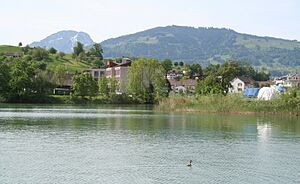Wangen, Schwyz facts for kids
Quick facts for kids
Wangen
|
||
|---|---|---|
 |
||
|
||
| Country | Switzerland | |
| Canton | Schwyz | |
| District | March | |
| Area | ||
| • Total | 8.46 km2 (3.27 sq mi) | |
| Elevation | 424 m (1,391 ft) | |
| Population
(Dec 2020 )
|
||
| • Total | 5,344 | |
| • Density | 631.7/km2 (1,636.0/sq mi) | |
| Postal code |
8855
|
|
| Surrounded by | Galgenen, Jona (SG), Lachen, Schübelbach, Tuggen | |
Wangen is a cool place in Switzerland! It's a municipality, which is like a town or local area, located in the March District in the canton of Schwyz. Wangen includes the main town and a smaller area called Nuolen.
Contents
What is Wangen Like?
Wangen is a beautiful area with a mix of nature and buildings.
As of 2006, Wangen covers about 8.5 square kilometers (around 3.3 square miles). A big part of this land, about 65%, is used for farming. Forests cover about 10% of the area. About 21% of the land has buildings or roads. The rest, about 3.6%, is made up of rivers or mountains. You can also find the Buechberg hill within Wangen.
A Look at Wangen's History
Wangen has a long history!
Back on January 21, 1407, a count named Fridrich von Toggenburg made an important gift. He gave the church, its rights, and lands in Wangen to the Rüti Monastery. He did this for his own well-being and to honor his ancestors. Knights like Herman von Landenberg and Johans von Bonstetten helped make this gift official.
Who Lives in Wangen?
Wangen is home to many people from different backgrounds.
Population and Languages
As of the latest count, Wangen has a population of 5,344 people. Over the past ten years, the number of people living here has grown by about 4.1%. Most people in Wangen, about 92%, speak German. Albanian is the second most common language, spoken by 2% of the people, followed by Italian at 1.7%.
Age and Households
In 2000, the population was almost evenly split between males (50.1%) and females (49.9%). Looking at age groups in 2008:
- About 27.5% of the people are young, between 0 and 19 years old.
- Around 30.8% are young adults, aged 20 to 39.
- Another 30.8% are adults, aged 40 to 64.
- About 6.8% are older adults, aged 65 to 74.
- About 3.1% are between 70 and 79.
- A small group, 0.9%, are over 80 years old.
In 2000, there were 1,753 households in Wangen. About 25.8% of these households had only one person. Around 7.3% were larger families with five or more members.
Politics and Education
In the 2007 election, the most popular political party was the SVP, which got 50.3% of the votes. Other popular parties included the SPS (17.7%), the FDP (15.5%), and the CVP (12.6%).
Many people in Wangen are well-educated. About 68.9% of adults aged 25-64 have finished high school or gone on to higher education, like university.
Jobs and Economy
Wangen has a low unemployment rate of 1.21%. In 2005, many people worked in different areas:
- Farming: 158 people worked in farming, with 56 businesses in this area.
- Manufacturing: 387 people worked in factories or making things, with 70 businesses.
- Services: 645 people worked in service jobs (like shops, offices, or healthcare), with 138 businesses.
Religious Beliefs
Based on the 2000 census, most people in Wangen are Christian:
- About 69.7% are Roman Catholic.
- About 16.4% belong to the Swiss Reformed Church.
- A small number of people belong to the Orthodox Church (1.94%) or other Christian churches.
- About 3.83% of the population are Islamic.
- Around 4.60% of people said they don't belong to any church, or are agnostic or atheist.
How Wangen's Population Has Changed Over Time
The table below shows how the number of people living in Wangen has grown over the years:
| Year | Population |
|---|---|
| 1900 | 1,131 |
| 1950 | 2,284 |
| 1960 | 2,550 |
| 1970 | 2,989 |
| 1980 | 2,847 |
| 1990 | 3,411 |
| 2000 | 4,572 |
| 2005 | 4,664 |
| 2010 | 4,672 |
| 2015 | 4,926 |
| 2020 | 5,321 |
| 2023 | 5,443 |
See also
 In Spanish: Wangen (Schwyz) para niños
In Spanish: Wangen (Schwyz) para niños






